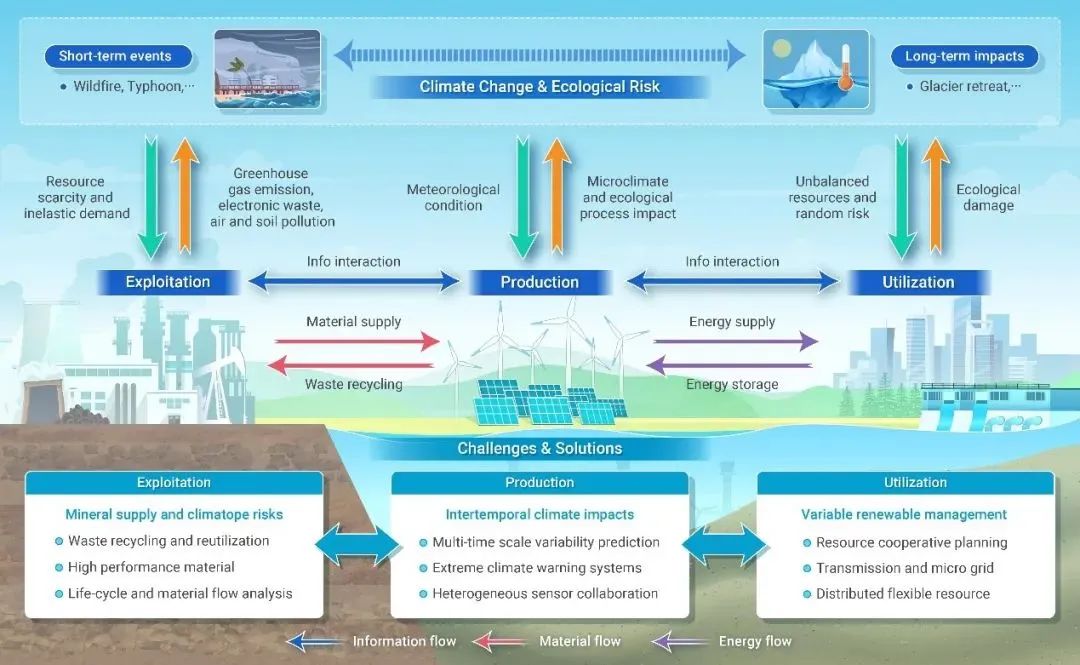Large-scale deployment of renewable energy is a critical measure to address the global energy crisis and achieve carbon neutrality goals. While countries worldwide are actively promoting the development of renewable energy, its exploitation and integration still face numerous challenges in technology, policy, and markets. Effectively accelerating the development and utilization of renewable energy has become a globally focused and cutting-edge issue. Recently, a research team led by Professor Lu Xi from the Institute for Carbon Neutrality and the School of Environment at Tsinghua University, in collaboration with teams from Peking University and China Agricultural University, systematically identified potential challenges in renewable energy development and utilization. From an integrated perspective of material flow, information flow, and energy flow, the team proposed innovative solutions to accelerate global renewable energy exploitation and integration.

Figure 1. Challenges and corresponding solutions in the production, development, and utilization of global renewable energy
The study indicates that the challenges in renewable energy development and utilization mainly exist at three levels. First, in terms of renewable energy production: traditional static assessment methods based on annual averages are insufficient for high-precision planning and policy-making; single natural attribute indicators struggle to support grid integration needs; and climate change (e.g., variations in wind speed, solar radiation, and extreme weather events) increasingly affects the stability of renewable energy production. Second, regarding renewable energy utilization: long-term fluctuations and uncertainties pose growing risks, and existing power systems are inadequate to handle the volatility brought by large-scale renewable integration. Third, concerning the environmental risks of the renewable energy industry chain: there is insufficient characterization of the spatiotemporal differences in environmental impacts and benefits; limited understanding of the direct benefits and mechanisms of renewable deployment on local ecology; increasing pressure on the supply of critical mineral resources; and challenges in managing renewable energy waste.
The study further proposes potential solutions for renewable energy development and utilization:
(1) Precision Assessment of Renewable Energy: Future technological development should focus on enhancing multi-scale climate prediction and risk management capabilities, revealing the temporal variability of renewables and its driving factors, and establishing long-term variability forecasting methods and risk early-warning mechanisms to ensure the stability of renewable production and the security of energy system operation.
(2) Efficient Utilization Mechanisms for Renewable Energy: Future efforts should develop active grid integration mechanisms covering power generation, transmission, and load management. Synergistic utilization mechanisms between supply and demand sides can be enhanced through interactive technologies such as demand response, electric vehicles, and energy storage to facilitate the absorption of distributed renewable energy. In transmission, flexible AC and high-voltage DC technologies can increase capacity, while microgrids and distributed generation can minimize long-distance transmission needs. In energy storage, coordinated use of long-term storage (e.g., hydrogen and pumped hydro) and short-term storage (e.g., electrochemical storage) can further reduce energy fluctuations.
(3) Renewable Energy Industry Chain: More environmentally friendly recycling technologies, such as hydrometallurgy and bioleaching, should be developed. Innovation in energy materials, particularly perovskite photovoltaic materials, is expected to improve solar conversion efficiency and reduce resource dependency. Meanwhile, life-cycle assessment methods should be adopted to evaluate the full environmental impact of energy products and enhance the sustainability of energy development.
In summary, accelerating global renewable energy development and utilization relies not only on technological breakthroughs but also on policy, market, and international cooperation. Countries should formulate tailored energy policies and promote technological innovation based on their resource endowments and technical conditions. Strengthening cross-border cooperation and integrating global energy markets will accelerate the worldwide application of renewable energy, driving a green, low-carbon transition and high-quality development in the energy sector.
The related findings, titled "Accelerating exploitation and integration of global renewable energy," were published in The Innovation, a journal under the Cell Press group, on March 11. Professor Lu Xi from Tsinghua University is the corresponding author. Dr. Wang Jianxiao and Dr. Chen Xinjiang from Peking University are co-first authors, and Dr. Zhuang Minghao from China Agricultural University is a co-corresponding author. Co-authors include Academician He Kebin, Associate Professor Zhang Ning, Dr. Li Yan, Dr. Ruan Ziwen, and Dr. Wang Yuhan from Tsinghua University, as well as Professor Song Jie from Peking University. The research was supported by the National Natural Science Foundation of China, the National Key R&D Program of China, and the Carbon Neutrality and Energy System Transformation (CNEST) Program, among others.
Paper Link:
https://www.cell.com/the-innovation/fulltext/S2666-6758(25)00076-1
 Latest recommendations
Latest recommendations


